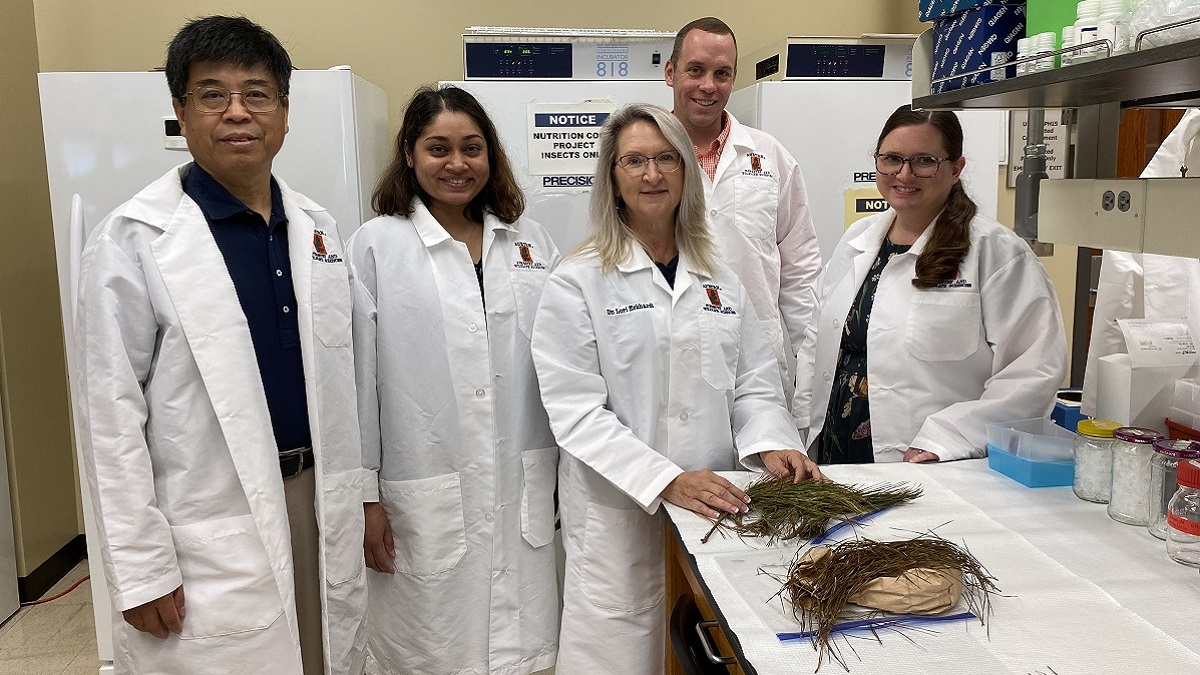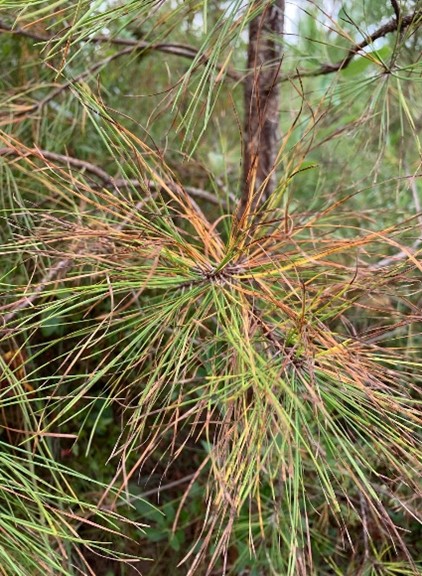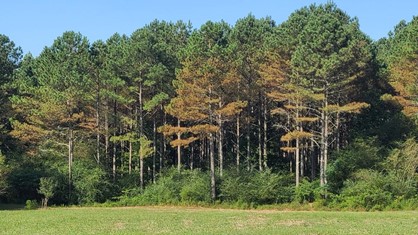Auburn University research team receives $2.1 million grant to mitigate growing threat to pine forests

An Auburn University research team is tackling the growing problem of brown spot needle blight that is hitting Alabama's pine forests. There is speculation that a new subspecies of fungal pest may have evolved. (contributed)
A research team in Auburn University’s College of Forestry, Wildlife and Environment (CFWE) is working to find solutions to an increasing threat to pine forests – needle blight.
Through a $2.1 million U.S. Forest Service grant, Lori Eckhardt, a professor of forest health, and her team members in the college are aiming to determine the impact on productivity and biological causes of needle blight. Working with Eckhardt are Joseph Fan, associate professor of forest ecology and statistics; Lana Narine, assistant professor of remote sensing and modeling; and Janna Willoughby, assistant professor of population and conservation genetics.
Insect pests and fungal diseases are a major concern to the forest industry. Costs associated with damage caused by non-native pests and pathogens in forests throughout the U.S. in 2000 were estimated at about $4.2 billion annually.
The Alabama Forestry Commission (AFC) has been receiving phone calls since early spring from landowners and the public regarding pine needles suddenly turning brown. The disease has been confirmed in 36 of 67 Alabama counties.

Brown spot needle blight now affects both longleaf and loblolly pines. (Alabama Forestry Commission)
Historically, the disease has infected only longleaf pines, but in the past few years, the disease has begun to infect loblolly pines in young and mature stands.
The AFC notes the first sign of infection is discoloration of the needles. Infected needles will contain circular lesions with a brown spot surrounded by a yellow halo.
Over time, the infected area will turn brown with a dark red or dark green border. The discoloration begins in the lower portion of the crown and moves up as the disease spreads by rain and wind. An easy way to identify the disease is if the pine needles look as if they have been scorched by fire, even though there has been no burn.
The cause for this change in behavior of the disease has yet to be determined, but it may be a new subspecies that has evolved from the original fungal pest, an AFC spokesman said.
“An investment in mitigating forest pests, such as those associated with needle blight, requires adaptive management geared to prevention and remediation that provide economically sound solutions,” said Eckhardt, director of the Forest Health Cooperative.
Through the team’s research, landowners and forest managers may be able to predict future timber revenues more precisely from affected stands and adjust management activities accordingly.
“We hope to determine the distribution and movement of the needle pathogens, determine if their appearance is due to more aggressive strains and understand the disease cycle and the environmental factors that drive their emergence and distribution,” Eckhardt said.
In 2020, Alabama sales of forest products and related sectors totaled more than $11 billion. The sustainability and profitability of pine forests rely on optimal tree growth. The continued introduction of non-native insect pests and fungal pathogens, as well as the movement of native forest pests into forest ecosystems, can result in significant economic impacts.
Another team member, J. Ryan Mitchell, a regional extension agent with the Alabama Extension System, will assist with outreach.

Brown spot needle blight has been identified this year in 36 of 67 Alabama counties. (Alabama Forestry Commission)
“One of the roles for Extension during this project is to create publications on the research that is being conducted and get that information out to the landowners and citizens of Alabama,” Mitchell said. “We will be providing workshops to train the trainers and teach others about the brown spot needle blight, how to identify it, the ecology and different management techniques.”
CFWE held a summer workshop at Auburn University to share current assessments of the brown spot needle blight. Expert presentations included identification, mitigation, genetic diversity and environmental factors.
“The knowledge produced by Eckhardt and her team will be used to develop best management practices for areas affected by needle blight,” said Janaki Alavalapati, dean of the College of Forestry, Wildlife and Environment. “It shall also help direct future research actions, especially when little is known regarding the impact of the pests and pathogens associated with loblolly pine in the Southeastern United States.”
Landowners are encouraged to contact their local AFC office if their pines are infected with brown spot needle blight. Symptomatic needles can be collected and brought to the Forest Health Dynamics Laboratory at Auburn University for confirmation.
This story originally appeared on Auburn University’s website.





